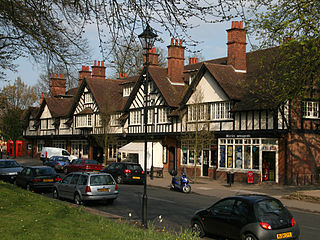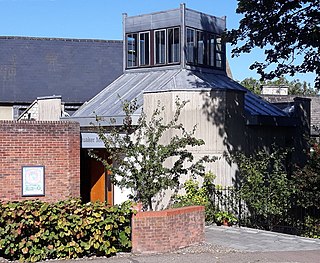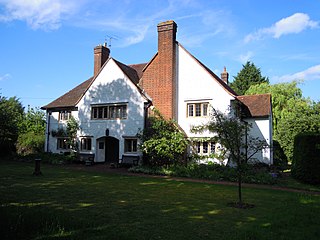
Bournville is a model village on the southwest side of Birmingham, England, founded by the Quaker Cadbury family for employees at its Cadbury's factory, and designed to be a "garden" village where the sale of alcohol was forbidden. Cadbury's is well known for chocolate products – including a dark chocolate bar branded Bournville. Historically in northern Worcestershire, it is also a ward within the council constituency of Selly Oak and home to the Bournville Centre for Visual Arts. Bournville is known as one of the most desirable areas to live in the UK; research by the Joseph Rowntree Foundation in 2003 found that it was "one of the nicest places to live in Britain".

William Alexander Harvey was an English architect. He is most notable for his design of Bournville, the model 'garden suburb' built by Cadburys to house their chocolate-making workforce to the south of Birmingham.

The Birmingham Hebrew Congregation, commonly known as the Singers Hill Synagogue, is an Orthodox Jewish synagogue in Birmingham, England. The synagogue is a Grade II* listed building, comprising 26, 26A and 26B Blucher Street in the city centre.

Wake Green is a historical area in south Birmingham, England between Moseley, Kings Heath, and Hall Green.

Julius Alfred Chatwin FRIBA, ARBS, FSAScot was a British architect. He was involved with the building and modification of many churches in Birmingham, and practised both Neo-Gothic and Neo-Classical styles. His designs always included all of the carvings and internal fittings.

The Moseley School of Art on Moseley Road, Balsall Heath, Birmingham, England was built as the first municipal branch School of Art in Birmingham.

The Public Library and Baths on Moseley Road, Balsall Heath, form one of many pairings of baths and libraries in Birmingham, England.

Dalton-Ellis Hall is a hall of residence complex at the University of Manchester in Manchester, England. It is situated in the south of the city on Conyngham Road in Victoria Park, next to St Chrysostom's Church. It is close to Wilmslow Road in Rusholme. Dalton-Ellis has 279 male and female residents in catered accommodation. The hall admits both undergraduate and postgraduate students, most are undergraduate first years.

Charles Edward Bateman FRIBA was an English architect, known for his Arts and Crafts and Queen Anne-style houses and commercial buildings in the Birmingham area and for his sensitive vernacular restoration and extension work in the Cotswolds.

St Francis of Assisi's Church, Bournville is a parish church in the Church of England in Bournville, Birmingham.

The Ifield Friends Meeting House is a Friends meeting house in the Ifield neighbourhood of Crawley, a town and borough in West Sussex, England. Built in 1676 and used continuously since then by the Quaker community for worship, it is one of the oldest purpose-built Friends meeting houses in the world. It is classified by English Heritage as a Grade I listed building, a status given to buildings of "exceptional interest" and national importance. An adjoining 15th-century cottage is listed separately at Grade II*, and a mounting block in front of the buildings also has a separate listing at Grade II. Together, these structures represent three of the 100 listed buildings and structures in Crawley.

The Brighton Friends Meeting House is a Friends meeting house in the centre of Brighton, part of the city of Brighton and Hove in East Sussex, England. The building, which dates from 1805, replaced an earlier meeting house of 1690 what was then a small fishing village on the Sussex coast. Located at the junction of Ship Street and Prince Albert Street in The Lanes, the heart of Brighton's "old town" area, its architectural and historic importance has been recognised by English Heritage's granting of Grade II listed status.

Northfield Manor House is a Manor House, on Bristol Road South, Northfield, Birmingham, England. It was formerly known as Manor Farm, and under that name was home to George and Elizabeth Cadbury.

Moseley Hall is a Grade II listed 18th-century country house which was situated in parkland in Moseley, Birmingham. The hall itself is now part of Moseley Hall Hospital and much of the surrounding estate has been developed for roads and housing.

Minworth Greaves is a timber cruck-framed, Grade II listed building in Bournville, an area of Birmingham, England. It is thought to date from the 14th-century or earlier, possibly as early as 1250. It is owned by the Bournville Village Trust. Minworth Greaves is situated next to Selly Manor, and is run as part of Selly Manor Museum. It was originally built in Minworth, near Sutton Coldfield to the North of Birmingham. After falling into extreme disrepair, it was purchased by George Cadbury and re-built by Laurence Cadbury in 1932 in the grounds of Selly Manor.

Stratford House is a Grade II* listed house in the Highgate area of Birmingham, England. Dating from 1601, it is located near Camp Hill traffic island. It was built by Ambrose and Bridget Rotton whose initials are carved over the porch. There is also an insurance plate on the front. The house was originally located on a 20-acre (8.1 ha) farm owned by Ambrose, who kept sheep, oxen, cows and pigs.

Godalming Friends Meeting House is a Friends meeting house in the ancient town of Godalming in the English county of Surrey. One of many Nonconformist places of worship in the town, it dates from 1748 but houses a congregation whose roots go back nearly a century earlier. Decline set in during the 19th century and the meeting house passed out of Quaker use for nearly 60 years, but in 1926 the cause was reactivated and since then an unbroken history of Quaker worship has been maintained. Many improvements were carried out in the 20th century to the simple brick-built meeting house, which is Grade II-listed in view of its architectural and historical importance.

Blackheath Quaker Meeting House is a Grade II listed building in the London Borough of Lewisham. It has been the home of Blackheath Quaker Meeting since 1972, and is also used by many community groups. Designed by Trevor Dannatt, it is believed to be the only Quaker Meeting House in Britain built in the Brutalist style. In the survey of Quaker meeting houses conducted by the Architectural History Practice for Historic England and Quakers in Britain it was described as a "Brutalist jewel" and "of exceptional aesthetic value".

Howgills in Letchworth Garden City, Hertfordshire, England, is a Grade II listed building on the Register of Historic England in use as a Meeting House for the Society of Friends (Quakers).



















